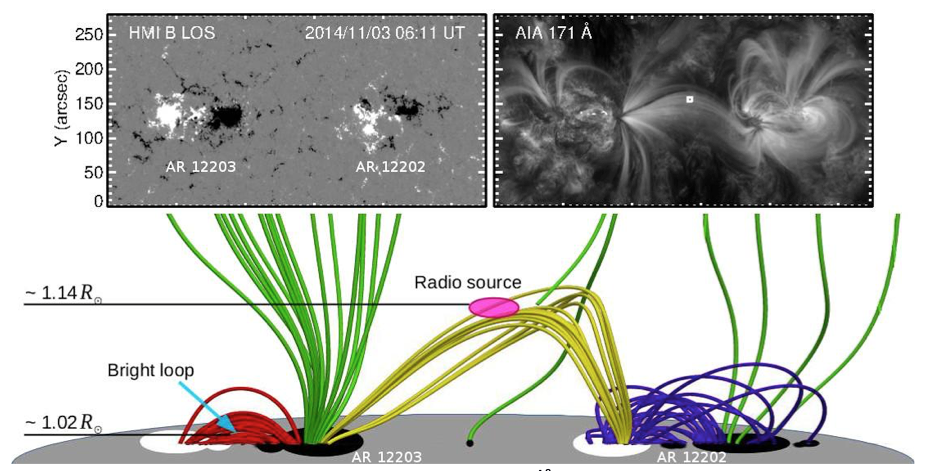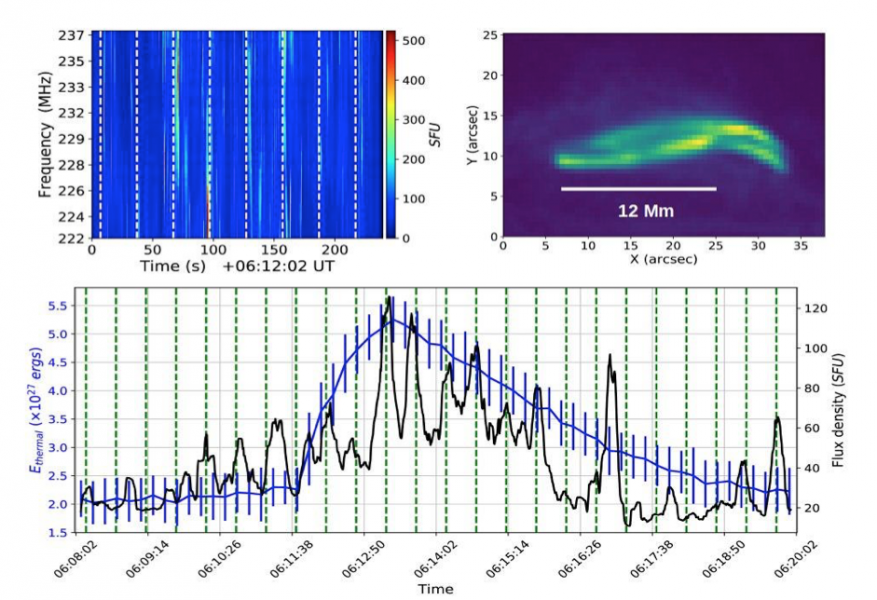Microflares are weaker cousins of large flares with 103 to 106 times less energies. They are also much more ubiquitous and frequent than larger flares. A very common phenomena of the Extreme Ultra-Violet (EUV) corona, namely the Active Region Transient Brightening (ARTB; Shimizu, 1996) event is known to be associated with microflares. The ARTBs are associated with active coronal loops of length ranging from 5 – 40 Mm and often produce energetic particle beams that generate type-III bursts. In this work, we study a dynamically linked ARTB – type-I noise storm system and study its dynamics using spatially resolved EUV, radio and magnetogram data. This is also the first spectroscopic radio imaging study of a type-I noise storm.
Observations and interpretation
On November 3, 2014, the Murchison Widefield Array (MWA) observed a noise storm associated with the active region AR 12203. Snapshot spectroscopic imaging was done at 160 kHz and 0.5 s resolution across a 15 MHz band centred around 200 MHz. SPatially REsolved Dynamic Spectrum (SPREDS), of the source was made by recording the flux density of the region of interest across all of the snapshot spectroscopic images.

Figure 1 – (Top left) HMI magnetogram (Top right) AIA 171image. (Bottom) NLFF extrapolation embedded on a cartoon of HMI magnetogram. The radio source and bright loop are marked.
Using Differential Emission Measure (DEM) analysis the thermal evolution of the ARTB source was studied, which revealed the microflare. The top left panel of Figure 1 shows the HMI magnetogram of AR 12203, that hosted the bright active region loop that underwent the ARTB event, along with the adjacent AR 12202. The top right panel shows the AIA 171image of the region revealing a large loop structure that connected the two active regions. Bottom panel shows the magnetic field derived using the Non-Linear Force Free (NLFF) extrapolation method. The radio noise storm source located at ~1.14 RSun and the bright loop are marked. The large loop structure and the bright loop share a common photospheric footpoint and hence should be subject to similar footpoint dynamics.

Figure 2 – (Top left) SPREDS for the noise storm during the microflare. Vertical lines are marked at 30 s intervals, (Top right) Bright loop region during the microflare. (Bottom) The band averaged radio light curve for the noise storm overlaid on the bright loop thermal energy evolution. Vertical lines are at 30 s.
Figure 2 shows the SPREDS for the noise storm during the microflare with vertical dashed lines marked at 30 s interval in the top left panel. SPREDS revealed numerous bright fine emission features, well modelled as coherent emission triggered by supra-thermal particle beams of speed ~ 14 – 17 Mm s-1. The top right panel shows the coronal loop which hosted the ARTB. The loop is braided/twisted at a scale of about 12 Mm. The bright fine structures in SPREDS are observed to clump together giving rise to a 30 s periodicity in the band averaged spatially resolved noise storm radio light curve shown in the bottom panel. We observe that the coherent flux density intensifies and pulsations became quite regular during the thermal energy rise phase associated with the microflare. They are present even before this phase, though are not as regular and are weaker in amplitude. The local magnetic free energy was estimated to be ~95% larger than the thermal energy released during the microflare, which makes it the plausible energy source for the event. Local Alfvén speed in the noise storm region was estimated to be 0.4 Mm s-1. Using this estimate and the 30 s timescale, a length scale was computed. This length scale estimate matches the braiding/twisting scale of 12 Mm seen in the bright loop region, suggesting an Alfvénic propagation of magnetic stress along the loops. This similarity in the spatial scales and the correlated evolution in emission light curves of the vastly separated noise storm and bright loop region, suggest a dynamical link between them. We propose a physical picture where by virtue of sharing the same magnetic footprint, these loops are subject to similar photospheric footpoint convective motions, magnetic stresses would build up across the large loop (from where the radio emission originates) at scales similar to the bright small loop (seen in the EUV), likely leading to a network of strands braided at a scale of ~12 Mm. Magnetic stress builds up across the braids and becomes unstable, triggering a series of reconnection events on 30 s timescale, which corresponds to the local Alfvén timescale for the observed braiding/twisting scale. These reconnection events generate supra-thermal particle beams, which set up the two-stream instability in the ambient plasma leading to coherent fine emission features in SPREDS. The observed 0.5 – 2 s lifetime of these features are consistent with the typical local ion-electron collisional damping timescale. Similar phenomena are likely happening at the bright loop region as well leading to heating. The Alfvén speeds at the bright loop region are much faster, leading to QPOs at timescale of a few seconds in the EUV bands. Observations at such rapid cadence is beyond the capacity of the present generation of EUV instruments.
Conclusions
The work presents the first spectroscopic imaging study of a metric noise storm source dynamically linked to an ARTB event hosted by a bright active region loop. The microflare associated with the ARTB was likely powered by the magnetic field dynamics. The extrapolated magnetic field structure revealed the association of the radio source with a large loop structure, that shared a photospheric footpoint with the bright loop. The magnetic stresses would build up at similar scales along each loop leading to a dominant braided network of magnetic strands with similar twist/braid scale. During the microflare, magnetic stress builds across this dominant network and relaxes at the local Alfvén timescale corresponding to brading length. This leads to periodic particle acceleration episodes that result in observed quasi-periodic pulsations in the noise storm light curve. A similar phenomena is likey to be happening at the bright loop region as well, which results in local heating.
Based on the recently publised paper: Mohan, A., McCauley, P., Oberoi, D. & Mastrano, A., (2019) ApJ, 883, 45 ; DOI: 10.3847/1538-4357/ab3a94
References
Shimizu, T. 1996, ASPCS, Vol. 111, 59
*Full list of authors: Atul Mohan, Patrick McCauley, Divya Oberoi & Alpha Mastrano
